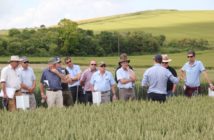HGCA has set out clear priorities for investing the cereals and oilseeds levy in research and knowledge exchange activities over the next five years.
Around 1000 individuals and organisations responded to the 2014 research consultation and provided their views on the challenges facing arable businesses.
Dr Vicky Foster, HGCA Research Team Leader, said: “From the outset, we knew the challenges would be diverse and the industry feedback has confirmed the complex nature of our farming systems and businesses.”
Following extensive analysis, the responses from the consultation were used to construct the new HGCA Investing in Innovation: Research & Knowledge Exchange Strategy 2015-2020.
The top five business challenges cited in the strategy revolve around dealing with cost/price pressures, pesticide availability, weed management, weather volatility and legislative impacts.
HGCA levy funds will now be invested to tackle three key strategic aims:
1. To inform on-farm decisions to increase productivity
2. To improve business opportunities through understanding product quality and making the most of market potential
3. To prepare the industry by assessing future challenges and conducting activity in response to these challenges.
Dr Foster continued: “In some respects, the publication of the strategy is the easy step – the real challenge is conducting new activity to meet the challenges outlined.
“Over the next five years, HGCA will develop a series of targeted calls. For each call, our research team will drill down into the business challenge and look for the most efficient way to address it.”
Knowledge exchange
Central to the success of the new strategy is the renewed importance placed on ‘knowledge exchange’ (KE).
Dr Foster said: “KE is a two-way process and requires effective dialogue between those who conduct research and those who benefit from it.
“In essence, KE can maximise the chances of a successful outcome from a project by involving the industry in the concept, the project and the tailoring of the project outcomes.
“We anticipate this process will not always reveal research activity is necessary – the answer may already be out there, we just need to find it, understand it and package it in a way that can be applied on farm.”
Value for money
Under the previous strategy, HGCA invested a total of £16.1m cereals and oilseeds levy across 102 diverse research projects and attracted £22.5m of co-funding.
In addition, a recent cost-benefit analysis of seven HGCA-funded research projects estimated an average 10-fold return for every pound of levy invested.
Under the new strategy, HGCA will continue to work with other AHDB divisions, government departments, research councils, commercial companies and other stakeholders in to order to leverage co-funding and add value to the levy.
Dr Foster concluded: “With limited funds, not all problems can be tackled but the development of a robust strategy helps HGCA calculate trade-offs and commission activities to meet the industry’s most pressing needs.”



